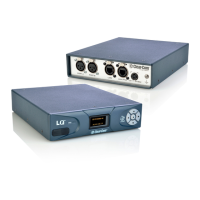10.4 4-wire port options
Note: To minimize noise, use screened (shielded) cable when connecting 4-wire ports.
Note: Default option is in bold.
• Label: Clicking on a blue label header will allow you to change the name of
the port. Enter the new name and either press the <ENTER> key or click
the blue check mark to apply changes.
• Input/Output gain: -12 to +12 dB
• Network Quality: Very Low/Low/Balanced/High/Very High/Custom
Note: The jitter buffer setting is designed to buffer audio received to prevent loss if there
is network jitter. Please note that the jitter buffer selection will directly affect the
latency. This is because the lower number in the jitter range represents the
amount of time the LQ unit will buffer audio before delivering it to the port. A
bigger jitter buffer setting will increase latency in milliseconds.
The Custom option within the Network Quality setting allows adjustment of the
jitter buffer setting independent of bit rate and packet size.
o Bitrate: 16, 32, 48, 64, 128 kbps
o Packet size: 5ms, 10ms, 20ms, 40ms, 60ms
o Jitter: (min – max) 200 – 1000ms, 100 – 500ms, 60 – 200ms, 40 -
100ms, 20 – 60ms, 5 – 60ms, to 3 – 60ms
• Vox: This setting maximises bandwidth efficiency by detecting when the
line is silent and not transmitting at those times. Choose from 3 different
settings:
o Disabled
o Fixed Threshold (user specified)
Delay: 0.5 to 4.0 seconds
Threshold: 0 to -42 dB. Default -22 dB
o Adaptive Threshold. This is the Opus Codec’s own silence suppression
(Discontinuous Transmission or DTX) mechanism. This option will
implement comfort noise when silence is detected.
• Port Function (sets pin polarity of Ethernet cable): to Panel /to Matrix
• Baud rate
9600 (Drake 4000)/19200 (Eclipse)

